Those of you who have kindly read many of my blogs will know that I grew up in Wales moving away to work in London at 21, well before my now obsessive interest in the organ took hold. And so perhaps it is not altogether surprising that the number of Welsh pipe organs I have played can be counted on the fingers of one hand. Before this trip would be over I would have more than doubled the number of Welsh church organs played.
I took very little persuading therefore when I received an invitation from David Gwesyn Smith to visit some of the interesting ‘Landmark’ pipe organs of South Wales. But this adventure turned out to be far more interesting, travelling as I was with a man of near encyclopaedic knowledge of a great many UK pipe organs and the detailed history of the churches and the development of Anglo Catholicism in Wales.
David has returned to the UK after a 30 year international career as a professional Baritone and choir master based in New York City. David protests that he is not an organist but he very ably demonstrated the instruments we visited and all but one of these I recorded while David played, so I hope you will enjoy the account of this trip that follows which includes some interesting Welsh church organs set in some architectural gems.
St Martin’s Church in Wales
On a wet and windy Thursday March afternoon our first stop was at St Martin’s Church in Roath, a suburb to the east of Cardiff. We were greeted by Father Irving Hamer and led inside the vast and now rather crisp interior of what was originally a much more ornate interior, detail lost when the church was bombed in 1941 being rebuilt in 1951.
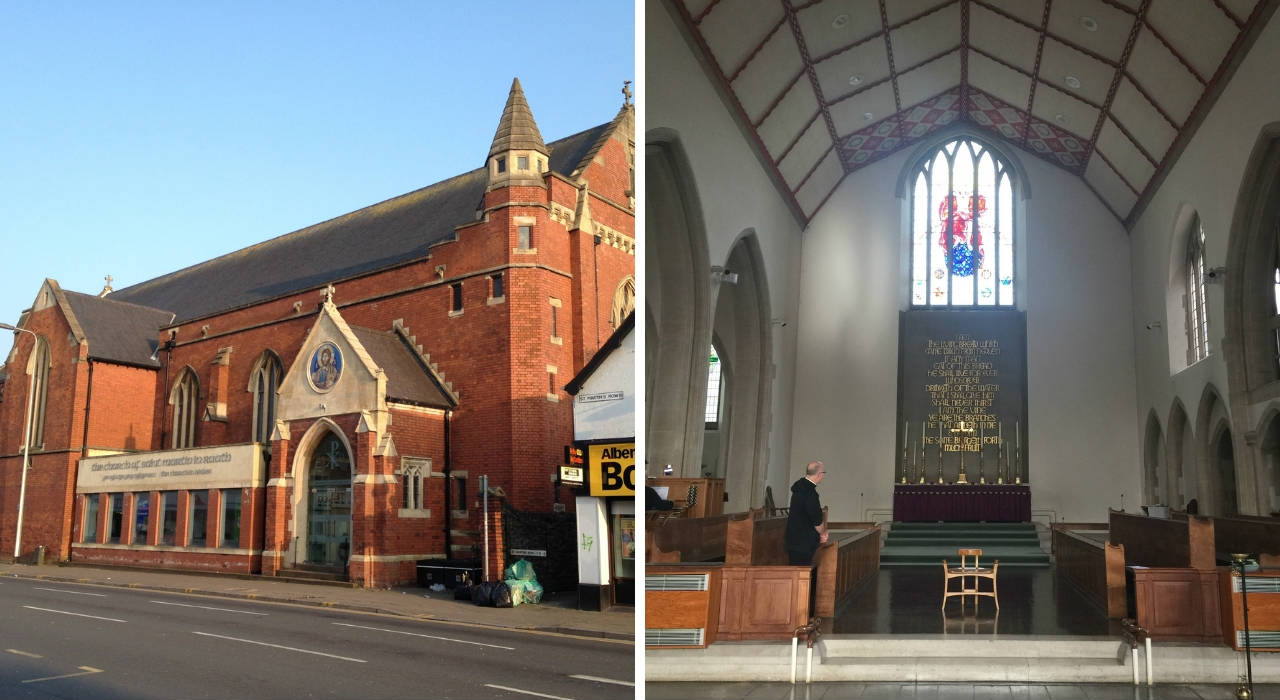
St Martin’s is a church in the Anglo Catholic tradition. The modern Anglo-Catholic movement began with the Oxford Movement in the Victorian era, and as David explained this was sometimes termed “Tractarianism”, a word new to my vocabulary. The traditional frescoes of this Victorian Anglo Catholic church, the life’s work of a Belgian refugee, were lost at St Martin’s due to war damage, but you get a sense of the original decorations from the post card image reproduced here.
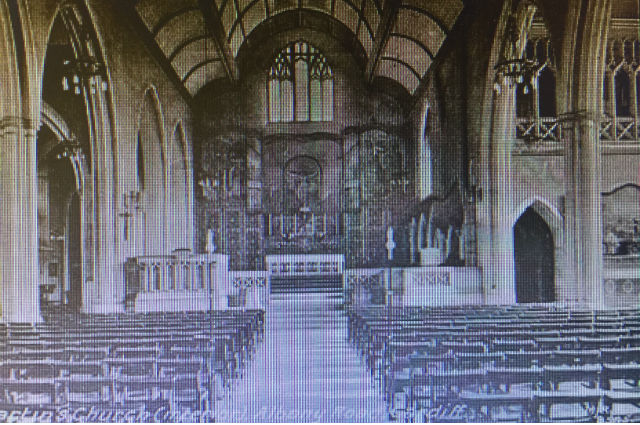
The first Welsh Church Organ visit
But our visit concerned the pipe organ and the instrument here started life as a 2 manual Hill later re-built in St Martins as a 3 manual by Compton. All this now played from a new console made in 2008 by our good friends Renatus of Devon. A well specified 3 manual, this instrument has the benefit of a very fine acoustic.
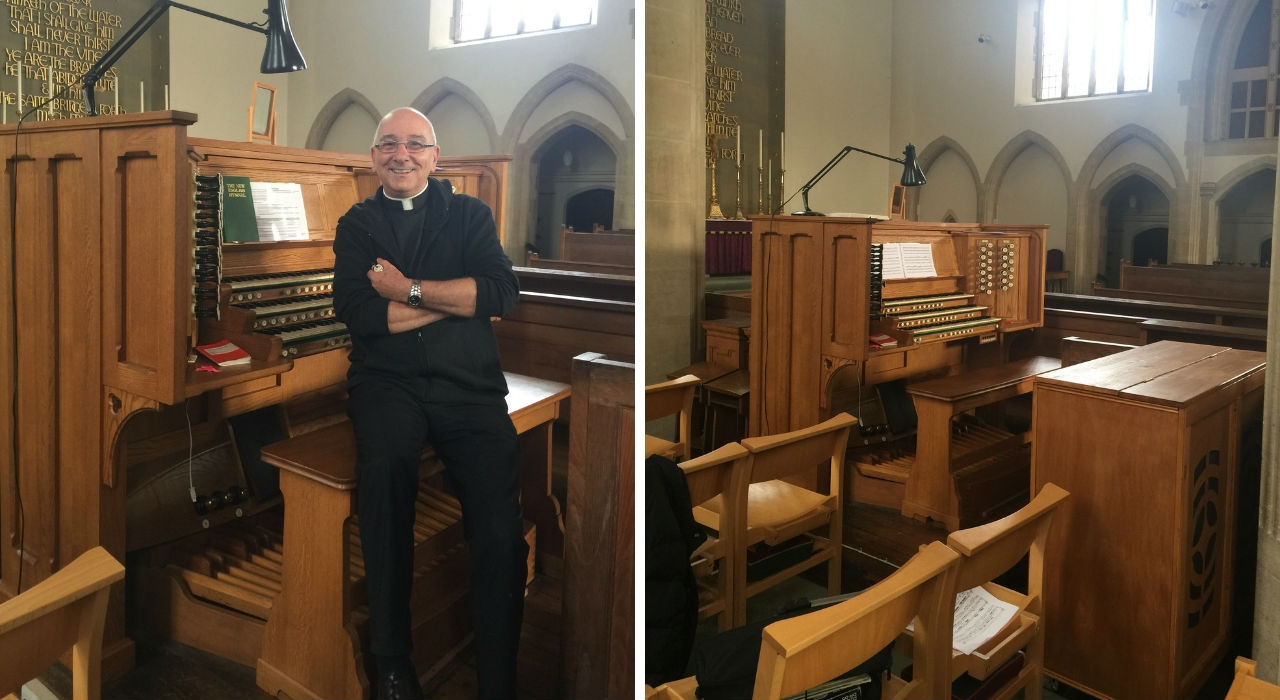
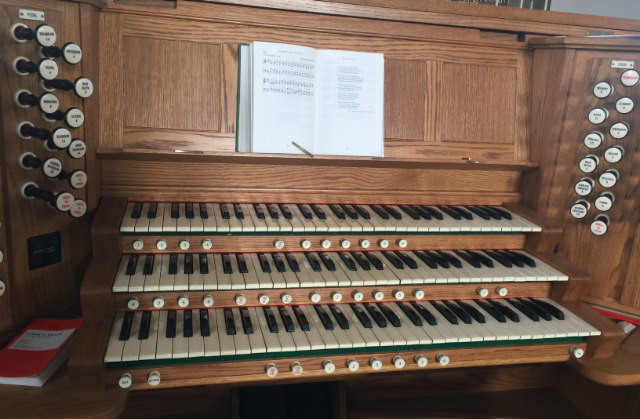
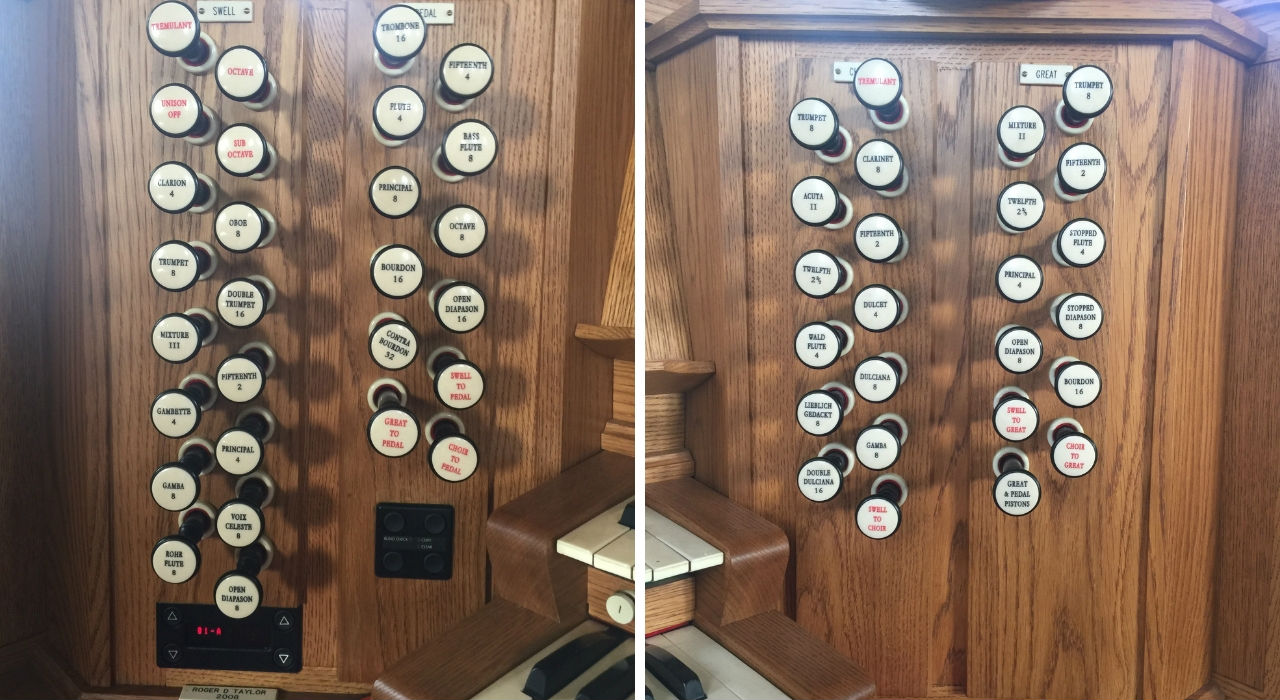
The pipes high on the south side of the nave are immediately opposite the console sited on the north side. But there is also a large portion of the instrument speaking directly into the south aisle. As is so often the case, the musician does not really hear just how powerfully the sound, much of which is behind him, is building up.
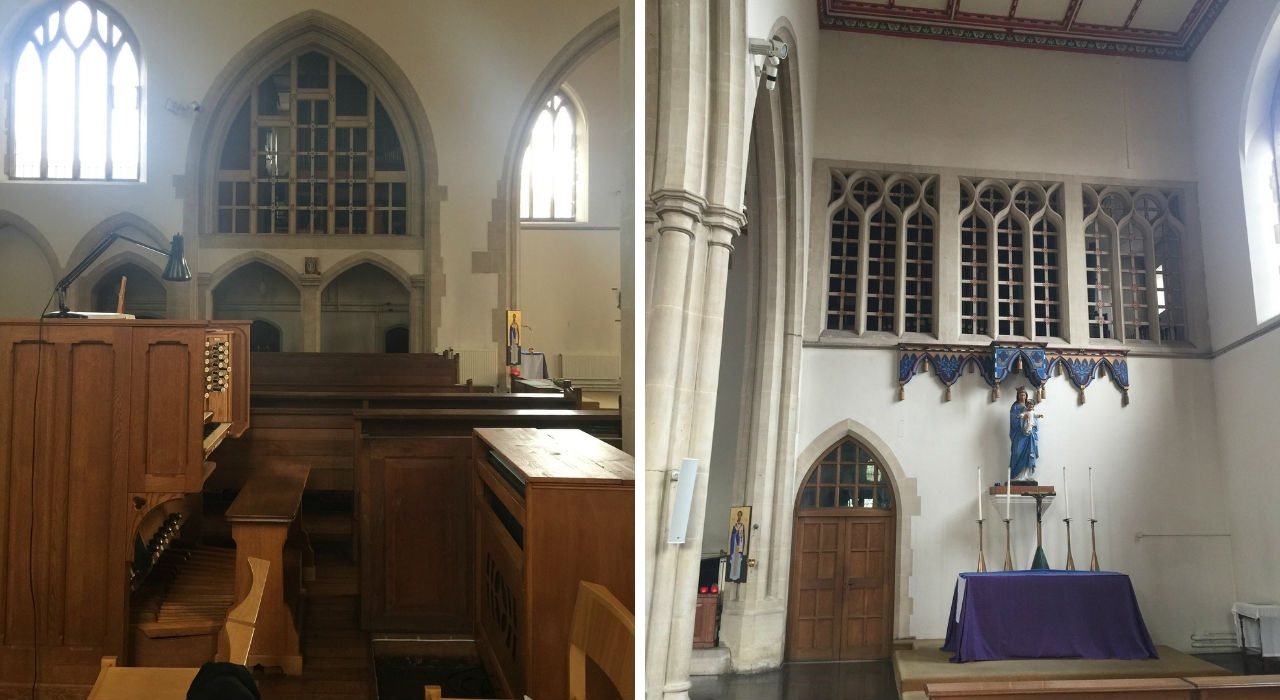
Also of great interest to me sitting adjacent to the organ console was what appeared to be a small chamber organ. However, on opening the lid one sees a Viscount Cantorum III which has been cleverly built into a stylish wooden cabinet. Of course, not quite up to the quality of our new Regent Classic Chamber Organ but it seems some years ago a person was thinking along the same lines as us.
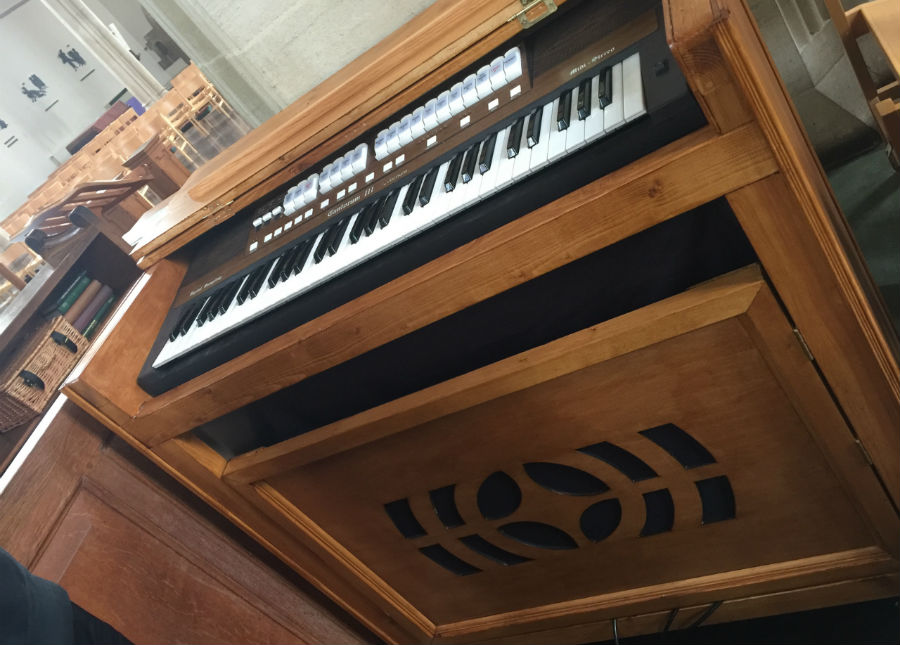
Sadly I did not record this instrument but I can assure you it speaks with dignity into this wonderfully forgiving space. As a fairly modest player I am always very happy to land on a bench where the acoustic hides deficiencies in technique and accuracy. St Martin’s is very generous on that score.
So after a very enjoyable session followed by tea and cakes in the vicarage we made our way the short distance to our next instrument at St German’s.
Our Second organ stop – St German’s – Church in Wales
At St German’s Church we were met by Angela Parry the parish treasurer who opened up and led us into what must surely be one of the best Victorian Churches of the Anglo Catholic movement in Wales.
St German’s, now Grade I listed, is undoubtedly the most famous of the Anglo-Catholic churches of Cardiff and one of the finest works of George Frederick Bodley (designed while he was in partnership with Thomas Garner). It built between 1881 and 1884. Rendel’s description of St German’s as “a sort of greyhound church, strong, lithe and thin” Amongst many fine features in this church, high on the south wall of the chancel of St. German’s is the particularly finely carved and painted organ case which has recently been restored to its former glory.
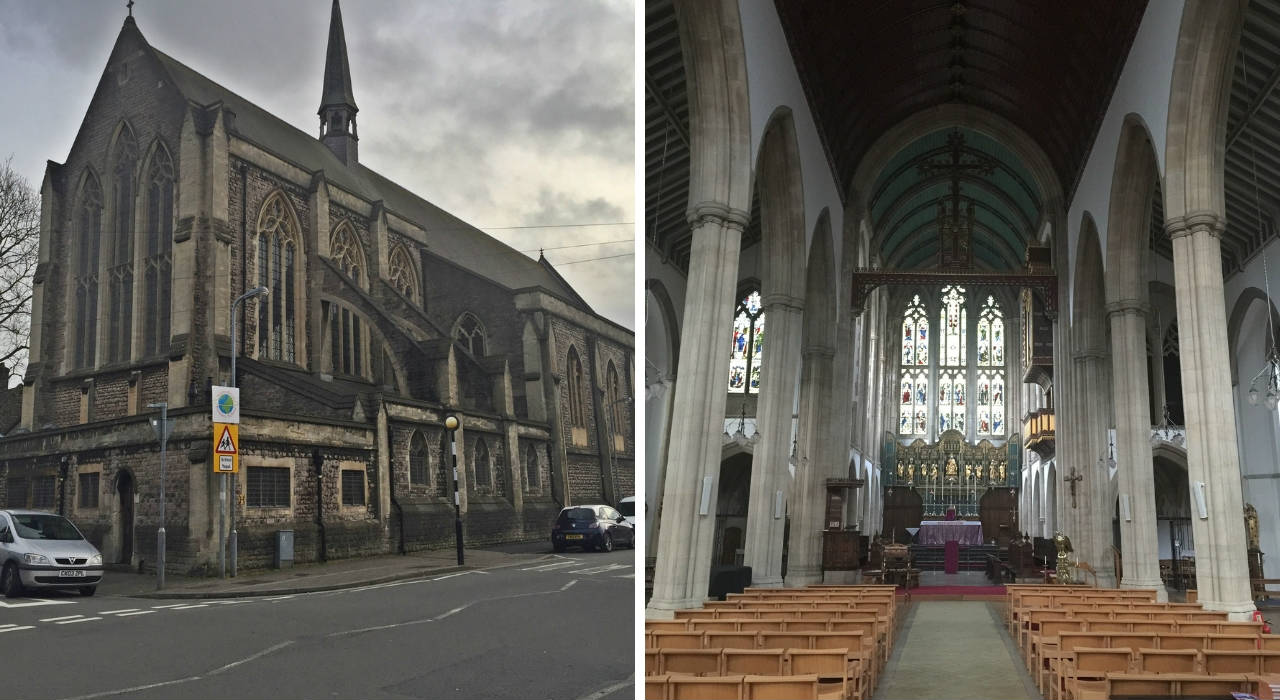
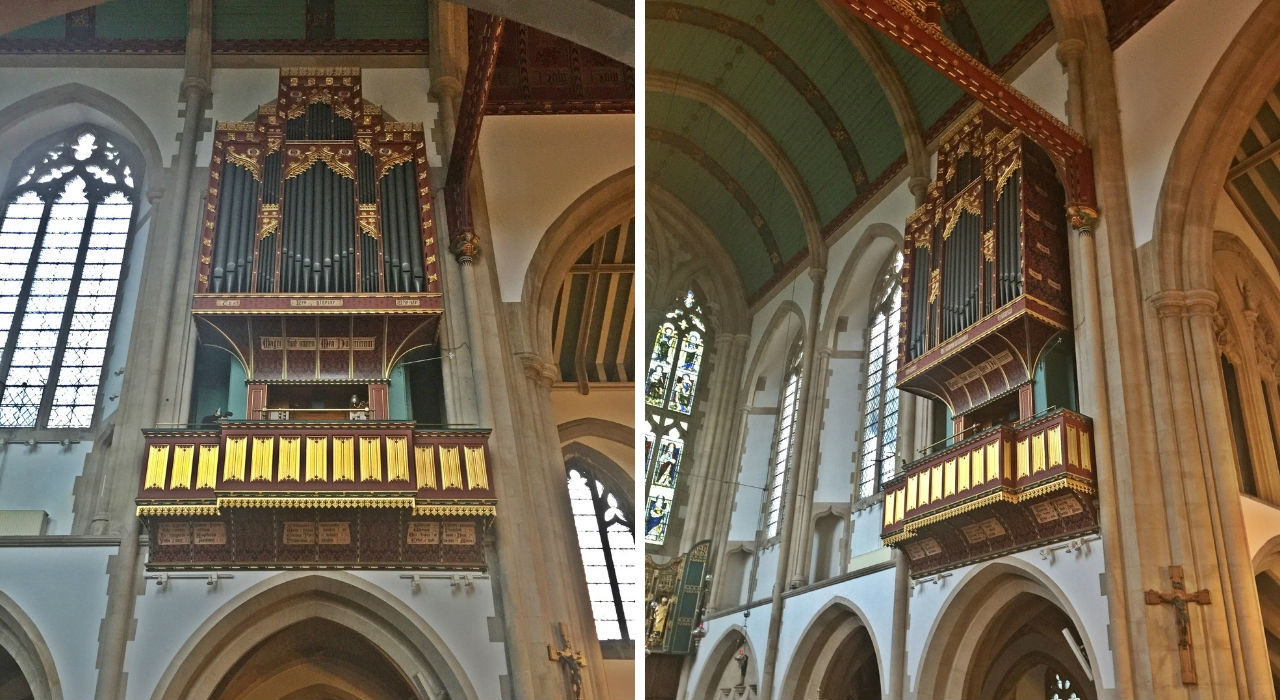
The Pipe Organ at St German’s Church
This organ has a BIOS grade II* listing underlining its significance as part of our organ heritage. The core of the instrument is Hill with a re-ordered choir organ using much original choir organ pipework by Willis in the 1960’s. The loft position is commanding if not just a little unnerving as the huge drop is just a few feet behind the organ bench and I rather doubt the balcony rail height now meets that required by modern building regulations.
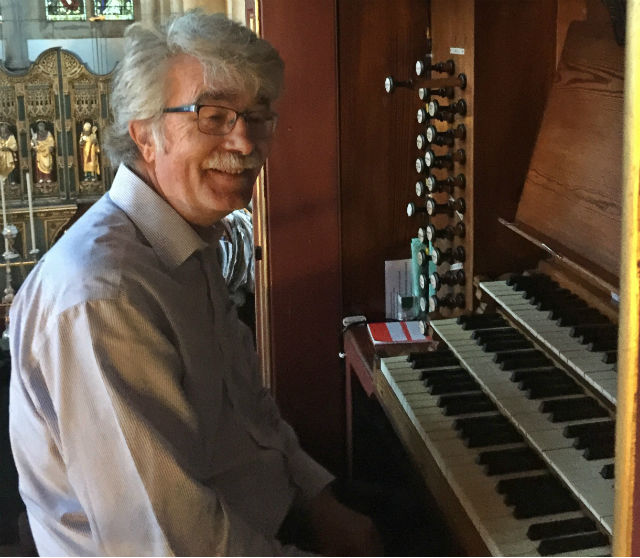
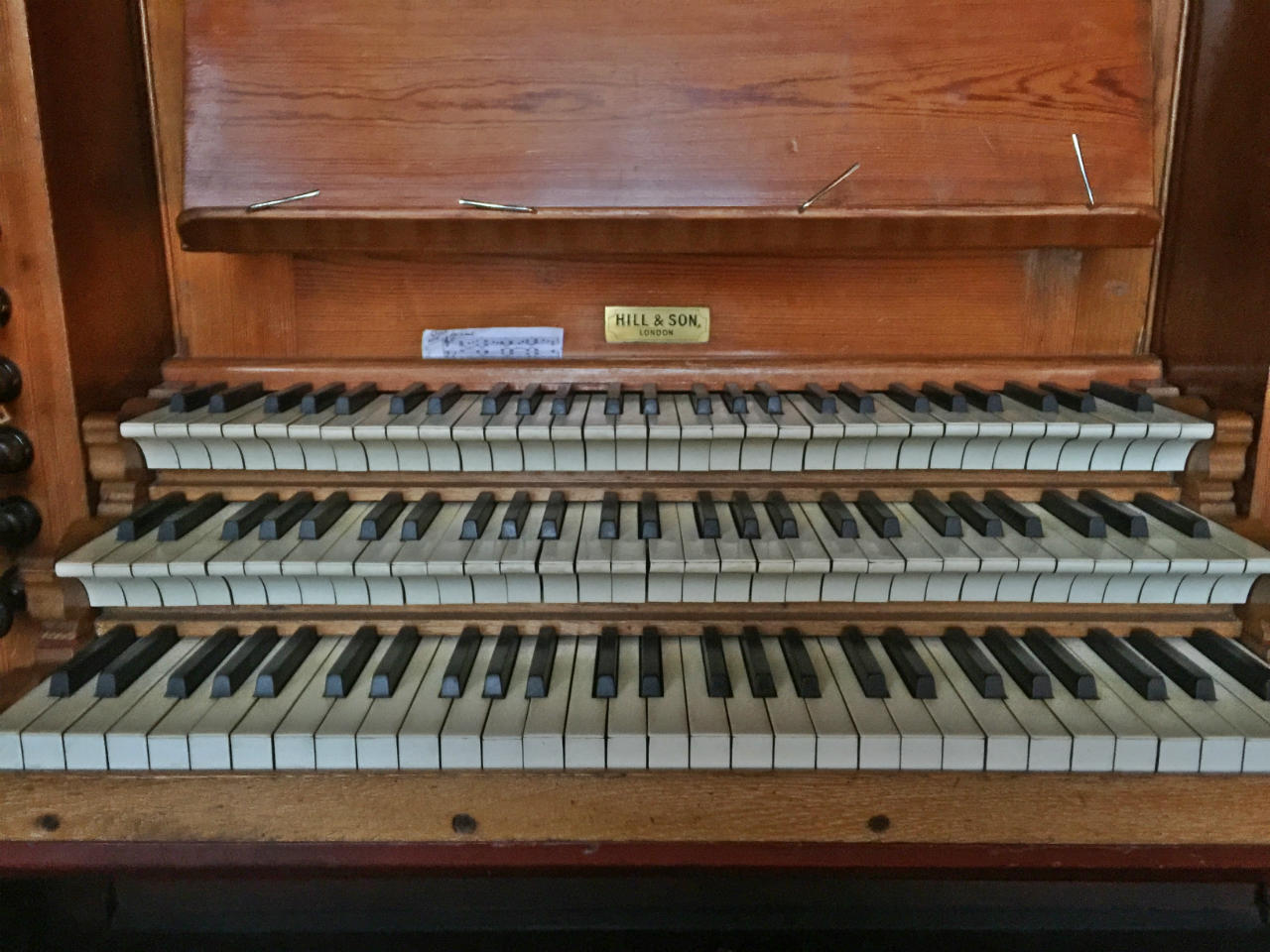
The instrument also boasts ‘barker lever action’ on the great which makes the use of coupled manuals lighter. This also adds what you will either regard as a quaint or irritating ‘chattering’ noise when the great manual is played, readily audible at the console, but lost by the time music has reached the nave.
Unlike St Martin’s the playing aids here are rudimentary but there are a few toe lever combinations that offer a degree of help if requiring a quick and significant registration change.
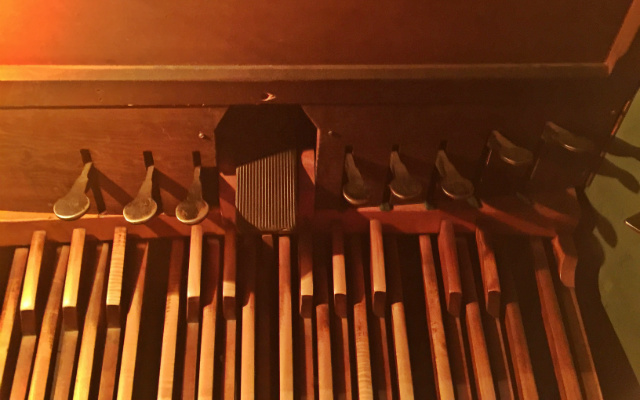
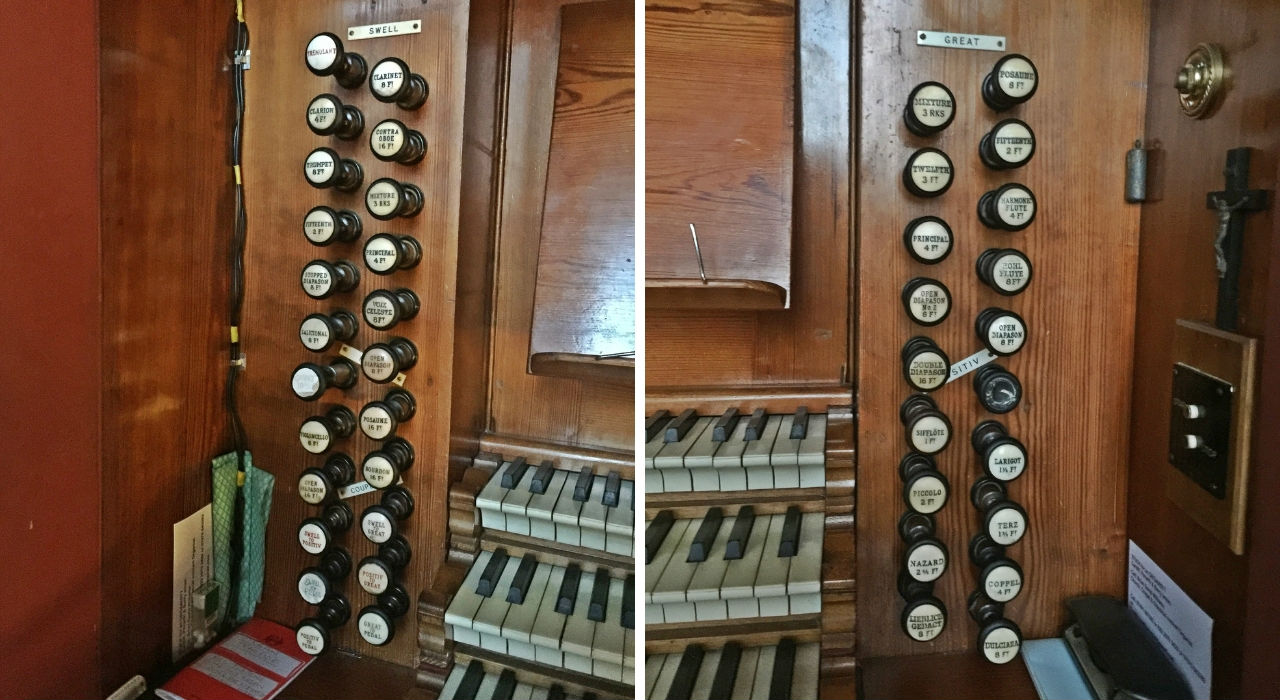
This is a grand organ and a grand loft from which to command and lead the congregation and choir below. The console arena is typically Hill with a lectern style music desk. The keyboards are comfortable and as you can see are the original ones now almost 140 years old, a little out of line in places but still working perfectly well.
Rather than take my word in regards St German’s pipe organ you can listen below to David Gwesyn Smith enjoying exploring the various voices of the fine Hill instrument.
Extraordinary detail of the Sanctuary
It would not be a complete account of the visit if I did not share with you the extraordinary detail of the sanctuary at St German’s. Anglo Catholic tradition has this as a highly formalised and decorated part of the church most often including a highly decorated reredos and 7 permanently lit sanctuary lamps hanging high above and in front of the altar. You see two of them in the picture below.
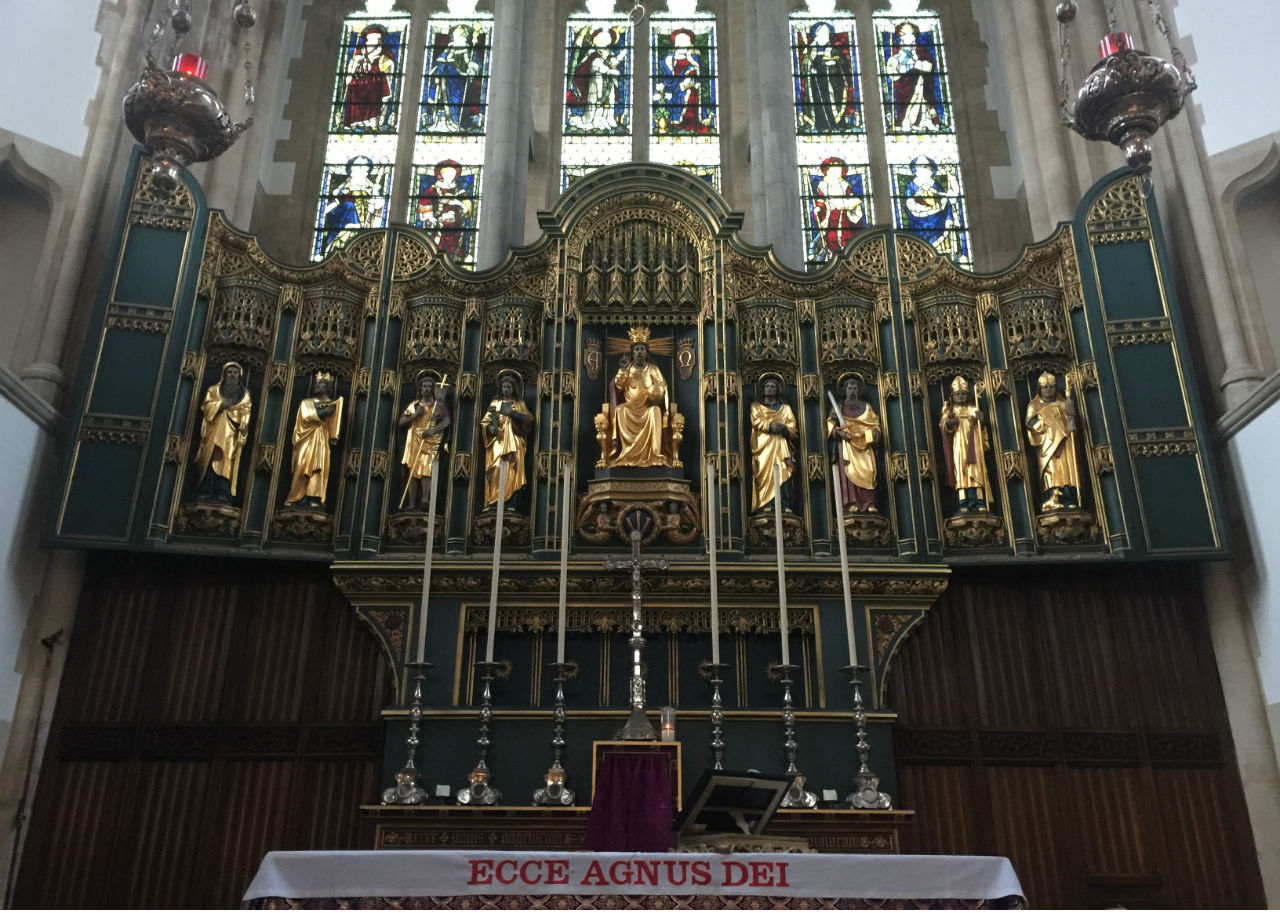
Depending upon your point of view the 7 lamps symbolise the 7 Christian virtues or the 7 early churches. Christ instructs John of Patmos to: “Write on a scroll what you see and send it to the seven churches: to Ephesus, and to Smyrna, and to Pergamum, and to Thyatira, and to Sardis, and to Philadelphia, and to Laodicea.”
The reredos at St German’s was erected in 1922 so it is a later addition and not part of the original design. Even so it fits perfectly, a memorial to recognise the 30 year service of the first priest James Ives. It towers above the altar filling the space below the east window and spanning the full width of the sanctuary. Wiser men than I will no doubt know the figures depicted, but they are certainly not exclusively the biblical characters that one might have expected.
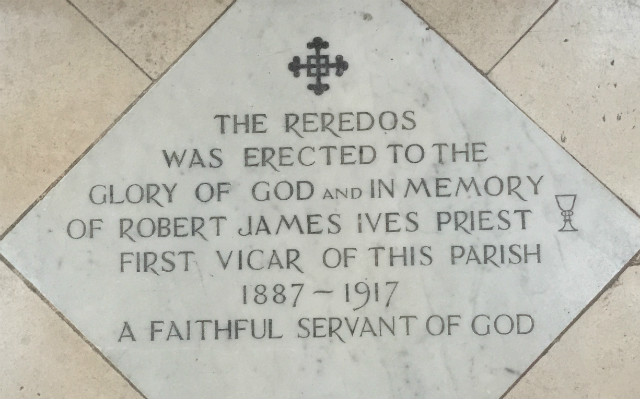
Onward to the next Church Pipe Organ in Wales
We left St German’s at about 7 pm for our next destination some four miles away. To learn about the next two church organs we visited follow the link below. The story of the four churches we fitted into the following day can be found soon on our blog.
Read Part Two of the Welsh Church Organ Pilgrimage >>
I have had a passion for church organs since the tender age of 12. I own and run Viscount Organs with a close attention to the detail that musicians appreciate; and a clear understanding of the benefits of digital technology and keeping to the traditional and emotional elements of organ playing.
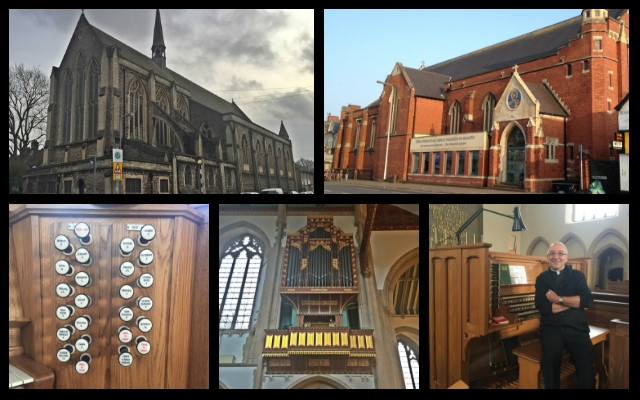



Dear David,
I had not read your “blog” before mentioning Llandaff Cathedral and now see that you actually visited it and played it.
A very interesting report indeed which I shall keep.My friend in Portugal would be interested to receive it without doubt.
What an incredible “Reredos” in S. Germans
Parish Church,reminds me of S.Andrew`s Worthing,where I periodically went as an Anglican.Those were the days before I became a Catholic,like S.John Henry Cardinal Newman.
I pray a safe and fruitful trip.
Regards until our next meeting,
John W.
I am the organist/choirmaster at this church. September 2021 is my 40th year here ! I was engaged by Fr. Martin Williams in 1981, the incumbent at the time. The sound of this organ is spiritually uplifting and always enthralls me . With hindsight, it is a pity that the original spec of the Choir Organ was altered. This was done in 1964 during a ‘fad’ of the period for a more “baroque” sound. . Some of the solo effects are fine, but the whole ensemble sits uneasily together as a chorus. . It is fortunate that the Great Organ was left as original. . However, the minor alterations to the Swell Organ spec is an improvement, I feel. The full Swell (16–8–4ft) with or without 15th, and mixture is thrilling. Overall, this is an organ in a sympathetic acoustic which would grace any cathedral; and surpass many present ‘modern’ cathedral organs ! >>>> Brian D. Williams November 2021.
Brian, Thank you for the additional information you provide and congratulations of passing the 40 years service mark. I am sure the quality of instrument is part of the draw that retains your services. Regards David